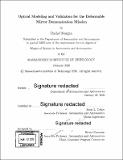Optical modeling and validation for the deformable mirror demonstration mission
Author(s)
Morgan, Rachel,S.M.(Rachel E.)Massachusetts Institute of Technology.
Download1199069355-MIT.pdf (8.799Mb)
Other Contributors
Massachusetts Institute of Technology. Department of Aeronautics and Astronautics.
Advisor
Kerri L. Cahoy.
Terms of use
Metadata
Show full item recordAbstract
Microelectromechanical Systems (MEMS) Deformable Mirrors (DMs) are a promising technology to enable the wavefront control required for high contrast imaging and characterization of exoplanets with coronagraph instruments. MEMS DMs are a key technology option for future exoplanet imaging space telescopes because they can provide precise wavefront control with low size, weight, and power required. The Deformable Mirror Demonstration Mission (DeMi) CubeSat mission will demonstrate MEMS DMs in the space environment for the first time. The DeMi payload will characterize the on-orbit performance of a 140 actuator MEMS DM with 5.5 [mu]m maximum stroke, with a goal of measuring individual actuator wavefront displacement contributions to a precision of 12 nm. The payload will be able to measure low order aberrations to [lambda]/10 accuracy and [lambda]/50 precision, and will correct static and dynamic wavefront phase errors to less than 100 nm RMS. The DeMi payload contains both a Shack Hartmann wavefront sensor and an image plane wavefront sensor to monitor the DM behavior on orbit. In this thesis, an optical diffraction model is developed to simulate the signals on both the Shack Hartmann wavefront sensor and the image plane wavefront sensor. The flight payload alignment and integration process is described, and the optical model is validated with relevant data from the flight payload. The DeMi satellite is expected to launch in February 2020.
Description
Thesis: S.M., Massachusetts Institute of Technology, Department of Aeronautics and Astronautics, 2020 Cataloged from PDF of thesis. Includes bibliographical references (pages 81-91).
Date issued
2020Department
Massachusetts Institute of Technology. Department of Aeronautics and AstronauticsPublisher
Massachusetts Institute of Technology
Keywords
Aeronautics and Astronautics.